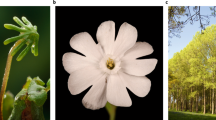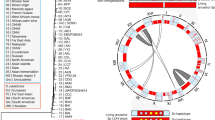Abstract
All plant and animal species arise by speciation — the evolutionary splitting of one species into two reproductively incompatible species. But until recently our understanding of the molecular genetic details of speciation was slow in coming and largely limited to Drosophila species. Here, I review progress in determining the molecular identities and evolutionary histories of several new 'speciation genes' that cause hybrid dysfunction between species of yeast, flies, mice and plants. The new work suggests that, surprisingly, the first steps in the evolution of hybrid dysfunction are not necessarily adaptive.
This is a preview of subscription content, access via your institution
Access options
Subscribe to this journal
Receive 12 print issues and online access
$189.00 per year
only $15.75 per issue
Buy this article
- Purchase on Springer Link
- Instant access to full article PDF
Prices may be subject to local taxes which are calculated during checkout

Similar content being viewed by others
References
Mayr, E. Systematics and the Origin of Species (Columbia Univ. Press, New York, 1942).
Coyne, J. A. & Orr, H. A. Speciation (Sinauer, Sunderland, Massachusetts, 2004).
Dobzhansky, T. Genetics and the Origin of Species 364 (Columbia Univ. Press, New York, 1937).
Muller, H. J. Isolating mechanisms, evolution, and temperature. Biol. Symp. 6, 71–125 (1942).
Rieseberg, L. H. & Willis, J. H. Plant speciation. Science 317, 910–914 (2007).
Baker, R. J. & Bickham, J. W. Speciation by monobrachial centric fusions. Proc. Natl Acad. Sci. USA 83, 8245–8248 (1986).
Bordenstein, S. R., O'Hara, F. P. & Werren, J. H. Wolbachia-induced incompatibility precedes other hybrid incompatibilities in Nasonia. Nature 409, 707–710 (2001).
Al-Kaff, N. et al. Detailed dissection of the chromosomal region containing the Ph1 locus in wheat Triticum aestivum: with deletion mutants and expression profiling. Ann. Bot. 101, 863–872 (2008).
Chen, J. et al. A triallelic system of S5 is a major regulator of the reproductive barrier and compatibility of indica–japonica hybrids in rice. Proc. Natl Acad. Sci. USA 105, 11436–11441 (2008).
Jeuken, M. J. W. et al. Rin4 causes hybrid necrosis and race-specific resistance in an interspecific lettuce hybrid. Plant Cell23 Oct 2009 (doi:10.1105/tpc.109.070334).
Long, Y. et al. Hybrid male sterility in rice controlled by interaction between divergent alleles of two adjacent genes. Proc. Natl Acad. Sci. USA 105, 18871–18876 (2008).
Schluter, D. & Conte, G. L. Genetics and ecological speciation. Proc. Natl Acad. Sci. USA 106, 9955–9962 (2009).
Dettman, J. R., Sirjusingh, C., Kohn, L. M. & Anderson, J. B. Incipient speciation by divergent adaptation and antagonistic epistasis in yeast. Nature 447, 585–588 (2007).
Lee, H.-Y. et al. Incompatibility of nuclear and mitochondrial genomes causes hybrid sterility between two yeast species. Cell 135, 1065–1073 (2008).
Barbash, D. A. Clash of the genomes. Cell 135, 1002–1003 (2008).
Jiang, H., Guan, W., Pinney, D., Wang, W. & Gu, Z. Relaxation of yeast mitochondrial functions after whole-genome duplication. Genome Res. 18, 1466–1471 (2008).
Costanzo, M. C., Bonnefoy, N., Williams, E. H., Clark-Walker, G. D. & Fox, T. D. Highly diverged homologs of Saccharomyces cerevisiae mitochondrial mRNA-specific translational activators have orthologous functions in other budding yeasts. Genetics 154, 999–1012 (2000).
Ellison, C. K., Niehuis, O. & Gadau, J. Hybrid breakdown and mitochondrial dysfunction in hybrids of Nasonia parasitoid wasps. J. Evol. Biol. 21, 1844–1851 (2008).
Harrison, J. S. & Burton, R. S. Tracing coadapted gene complexes to single amino acid substitutions. Mol. Biol. Evol. 23, 559–564 (2006).
Lynch, M. & Force, A. G. The origin of interspecific genomic incompatibility via gene duplication. Am. Nat. 156, 590–605 (2000).
Bikard, D. et al. Divergent evolution of duplicate genes leads to genetic incompatibilities within A. thaliana. Science 323, 623–626 (2009).
Masly, J. P., Jones, C. D., Noor, M. A. F., Locke, J. & Orr, H. A. Gene transposition as a novel cause of hybrid male sterility. Science 313, 1448–1450 (2006).
Lynch, M. & Conery, J. S. The evolutionary fate and consequences of duplicate genes. Science 290, 1151–1155 (2000).
Scannell, D., Byrne, K., Gordon, J., Wong, S. & Wolfe, K. Multiple rounds of speciation associated with reciprocal gene loss in polyploid yeasts. Nature 440, 341–345 (2006).
Bomblies, K. et al. Autoimmune response as a mechanism for a Dobzhansky–Muller-type incompatibility syndrome in plants. PLoS Biol. 5, e236 (2007).
Bomblies, K. & Weigel, D. Hybrid necrosis: autoimmunity as a potential gene-flow barrier in plant species. Nature Rev. Genet. 8, 382–393 (2007).
Bakker, E. G., Toomajian, C., Kreitman, M. & Bergelson, J. A genome-wide survey of R gene polymorphisms in Arabidopsis. Plant Cell 18, 1803–1818 (2006).
Sawamura, K. & Yamamoto, M.-T. Characterization of a reproductive isolation gene, zygotic hybrid rescue, of Drosophila melanogaster by using minichromosomes. Heredity 79, 97–103 (1997).
Ferree, P. M. & Barbash, D. A. Species-specific heterochromatin prevents mitotic chromosome segregation to cause hybrid lethality in Drosophila. PLoS Biol. 7, e1000234 (2009).
Charlesworth, B., Sniegowski, P. & Stephan, W. The evolutionary dynamics of repetitive DNA in eukaryotes. Nature 371, 215–220 (2002).
Fishman, L. & Saunders, A. Centromere-associated female meiotic drive entails male fitness costs in monkeyflowers. Science 322, 1559–1562 (2008).
Henikoff, S., Ahmad, K. & Malik, H. S. The centromere paradox: stable inheritance with rapidly evolving DNA. Science 293, 1098–1102 (2001).
Orr, H. A. & Irving, S. Segregation distortion in hybrids between the Bogota and USA subspecies of Drosophila pseudoobscura. Genetics 169, 671–682 (2005).
Phadnis, N. & Orr, H. A. A single gene causes both male sterility and segregation distortion in Drosophila hybrids. Science 323, 376–379 (2008).
Tao, Y., Masly, J. P., Araripe, L., Ke, Y. & Hartl, D. L. A sex-ratio meiotic drive system in Drosophila simulan s. I: an autosomal suppressor. PLoS Biol. 5, e292 (2007).
Tao, Y., Hartl, D. L. & Laurie, C. C. Sex-ratio segregation distortion associated with reproductive isolation in Drosophila. Proc. Natl Acad. Sci. USA 98, 13183–13188 (2001).
Mihola, O., Trachtulec, Z., Vlcek, C., Schimenti, J. C. & Forejt, J. A mouse speciation gene encodes a meiotic histone H3 methyltransferase. Science 323, 373–375 (2008).
Tao, Y. et al. A sex-ratio meiotic drive system in Drosophila simulans. II: an X-linked distorter. PLoS Biol. 5, e293 (2007).
Meiklejohn, C. D. & Tao, Y. Genetic conflict and sex chromosome evolution. Trends Ecol. Evol.24 Nov 2009 (doi:10.1016/j.tree.2009.10.005).
Barbash, D. A., Siino, D. F., Tarone, A. M. & Roote, J. A rapidly evolving MYB-related protein causes species isolation in Drosophila. Proc. Natl Acad. Sci. USA 100, 5302–5307 (2003).
Brideau, N. J. et al. Two Dobzhansky–Muller genes interact to cause hybrid lethality in Drosophila. Science 314, 1292–1295 (2006).
Ting, C.-T., Tsaur, S.-C., Wu, M.-L. & Wu, C.-I. A rapidly evolving homeobox at the site of a hybrid sterility gene. Science 282, 1501–1504 (1998).
Bayes, J. J. & Malik, H. S. Altered heterochromatin binding by a hybrid sterility protein in Drosophila sibling species. Science 326, 1538–1541 (2009).
Barbash, D. A., Awadalla, P. & Tarone, A. M. Functional divergence caused by ancient positive selection of a Drosophila hybrid incompatibility locus. PLoS Biol. 2, 839–848 (2004).
Tang, S. & Presgraves, D. C. Evolution of the Drosophila nuclear pore complex results in multiple hybrid incompatibilities. Science 323, 779–782 (2009).
Presgraves, D. C., Balagopalan, L., Abmayr, S. M. & Orr, H. A. Adaptive evolution drives divergence of a hybrid inviability gene between two species of Drosophila. Nature 423, 715–719 (2003).
Presgraves, D. C. & Stephan, W. Pervasive adaptive evolution among interactors of the Drosophila hybrid inviability gene, Nup96. Mol. Biol. Evol. 24, 306–314 (2007).
Presgraves, D. C. Does genetic conflict drive molecular evolution of nuclear transport genes in Drosophila? BioEssays 29, 386–391 (2007).
Orr, H. A. & Turelli, M. The evolution of postzygotic isolation: accumulating Dobzhansky–Muller incompatibilities. Evolution 55, 1085–1094 (2001).
Acknowledgements
I thank C. Meiklejohn and three anonymous reviewers for comments on the manuscript. Work in my laboratory is supported by funds from the US National Institutes of Health, the David & Lucile Packard Foundation, the Alfred P. Sloan Foundation and the University of Rochester.
Author information
Authors and Affiliations
Ethics declarations
Competing interests
The author declares no competing financial interests.
Rights and permissions
About this article
Cite this article
Presgraves, D. The molecular evolutionary basis of species formation. Nat Rev Genet 11, 175–180 (2010). https://doi.org/10.1038/nrg2718
Published:
Issue Date:
DOI: https://doi.org/10.1038/nrg2718
This article is cited by
-
A lethal mitonuclear incompatibility in complex I of natural hybrids
Nature (2024)
-
Indel driven rapid evolution of core nuclear pore protein gene promoters
Scientific Reports (2023)
-
Genomic patterns of divergence in the early and late steps of speciation of the deep-sea vent thermophilic worms of the genus Alvinella
BMC Ecology and Evolution (2022)
-
Rapid divergence of a gamete recognition gene promoted macroevolution of Eutheria
Genome Biology (2022)
-
Physiological aspects of sex differences and Haldane’s rule in Rumex hastatulus
Scientific Reports (2022)



